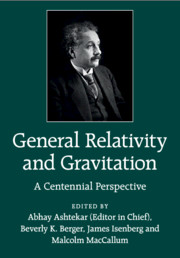Book contents
- Frontmatter
- Contents
- Preface
- List of contributors
- List of figures
- List of tables
- Part One Einstein's Triumph
- Part Two New Window on the Universe: Gravitational Waves
- Part Three Gravity is Geometry, after all
- Part Four Beyond Einstein
- 10 Quantum Fields in Curved Spacetime
- 11 From General Relativity to Quantum Gravity
- 12 Quantum Gravity via Supersymmetry and Holography
- Index
- References
11 - From General Relativity to Quantum Gravity
from Part Four - Beyond Einstein
Published online by Cambridge University Press: 05 June 2015
- Frontmatter
- Contents
- Preface
- List of contributors
- List of figures
- List of tables
- Part One Einstein's Triumph
- Part Two New Window on the Universe: Gravitational Waves
- Part Three Gravity is Geometry, after all
- Part Four Beyond Einstein
- 10 Quantum Fields in Curved Spacetime
- 11 From General Relativity to Quantum Gravity
- 12 Quantum Gravity via Supersymmetry and Holography
- Index
- References
Summary
Introduction
The necessity of reconciling general relativity (GR) with quantum physics was recognized by Einstein [1] already in 1916 when he wrote:
“Nevertheless, due to the inner-atomic movement of electrons, atoms would have to radiate not only electro-magnetic but also gravitational energy, if only in tiny amounts. As this is hardly true in Nature, it appears that quantum theory would have to modify not only Maxwellian electrodynamics, but also the new theory of gravitation.”
Yet, almost a century later, we still do not have a satisfactory reconciliation. Why is the problem so difficult? An obvious response is that this is because there are no observations to guide us. However, this cannot be the entire story because, if there are no observational constraints, one would expect an overabundance of theories, not scarcity!
The viewpoint in approaches discussed in this Chapter is that the primary obstacle is rather that, among fundamental forces of Nature, gravity is special: it is encoded in the very geometry of space-time. This is a central feature of GR, a crystallization of the equivalence principle that lies at the heart of the theory. Therefore, one argues, it should be incorporated at a fundamental level in a viable quantum theory. The perturbative treatments which dominated the field since the 1960s ignored this aspect of gravity. They assumed that the underlying spacetime can be taken to be a continuum, endowed with a smooth background geometry, and the quantum gravitational field can be treated just like any other quantum field on this background. But the resulting quantum GR turned out to be non- renormalizable; the strategy failed by its own criteria. The new strategy is to free oneself of the background spacetime that seemed indispensable for formulating and addressing physical questions; the goal is to lift this anchor and learn to sail the open seas. This task requires novel mathematical techniques and conceptual frameworks.
- Type
- Chapter
- Information
- General Relativity and GravitationA Centennial Perspective, pp. 553 - 611Publisher: Cambridge University PressPrint publication year: 2015
References
- 11
- Cited by

